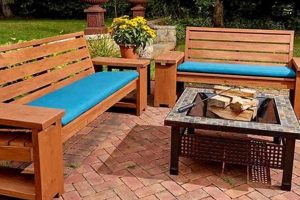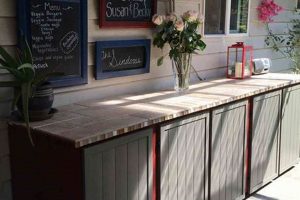The creation of exterior furnishings by individuals, rather than purchasing pre-made items, represents a growing trend. This encompasses a wide range of projects, from repurposing existing materials like pallets into seating, to constructing entirely new pieces using lumber and hardware. For example, building a picnic table from reclaimed wood constitutes a typical undertaking within this domain.
This approach offers several advantages. Primarily, it allows for customization to fit specific spatial requirements and aesthetic preferences. Furthermore, it often proves more cost-effective than retail purchases, particularly when utilizing recycled components. Historically, self-sufficiency in crafting household items has been a necessity for many, and this practice persists today, driven by both economic and environmental considerations.
Subsequent sections will delve into specific project ideas, material selection best practices, essential tools for construction, and crucial safety precautions to observe during the fabrication process. The discussion will also address strategies for ensuring durability and weather resistance in such projects.
Essential Guidance for Exterior Furnishing Projects
The following guidance is designed to enhance the success and longevity of self-made exterior furnishings. Adherence to these points will improve both the aesthetic and functional aspects of completed projects.
Tip 1: Material Selection is Paramount: Prioritize weather-resistant materials like cedar, redwood, or treated lumber. Untreated materials are susceptible to rot, insect infestation, and rapid degradation when exposed to the elements.
Tip 2: Precise Measurements Ensure Quality: Accurate measurements are critical for achieving structural integrity and visual appeal. Double-check all dimensions before cutting materials to minimize errors and waste.
Tip 3: Utilize Appropriate Fasteners: Exterior projects require corrosion-resistant fasteners such as stainless steel or galvanized screws. Standard screws will rust and weaken over time, compromising the structural integrity of the furniture.
Tip 4: Apply Protective Finishes: Seal, stain, or paint completed items with products designed for exterior use. These finishes provide a barrier against moisture, UV radiation, and other environmental factors.
Tip 5: Structural Integrity is Non-Negotiable: Reinforce joints and connections with brackets, braces, or additional fasteners as needed. A strong foundation is essential for ensuring the safety and stability of the furniture.
Tip 6: Consider Ergonomics and Comfort: Design furniture with user comfort in mind. Consider seat height, back support, and armrest placement to maximize usability and enjoyment.
Tip 7: Prioritize Safety Throughout the Process: Wear appropriate safety gear, including eye protection, gloves, and respiratory protection, when cutting, sanding, or applying finishes. Always operate power tools according to the manufacturer’s instructions.
By following these guidelines, individuals can create durable, attractive, and functional exterior furnishings that enhance their outdoor spaces.
The concluding sections will address maintenance strategies and ideas for personalizing projects to reflect individual styles and preferences.
1. Durability
Durability is a paramount consideration in the realm of self-constructed exterior furnishings. The inherent exposure to environmental elements necessitates a focus on materials and construction methods that promote longevity and resistance to degradation. Neglecting durability considerations will result in premature failure and negate the economic and aesthetic benefits of undertaking such projects.
- Material Selection for Weather Resistance
The choice of materials directly impacts the resilience of outdoor furniture. Certain wood species, such as cedar, redwood, and teak, possess natural oils and compounds that inhibit rot and insect infestation. Pressure-treated lumber offers enhanced protection against these threats. Conversely, untreated softwoods are highly susceptible to deterioration, necessitating rigorous and potentially costly maintenance.
- Joint Construction and Fastener Selection
The manner in which individual components are joined together is crucial for structural integrity. Strong, well-executed joints minimize stress points and prevent premature failure. Furthermore, the selection of appropriate fasteners is essential. Corrosion-resistant screws and bolts, such as those made from stainless steel or galvanized steel, are necessary to withstand exposure to moisture and prevent weakening of the connections.
- Protective Finishes and Treatments
The application of protective finishes serves as a barrier against environmental damage. Exterior-grade paints, stains, and sealants provide resistance to moisture penetration, ultraviolet radiation, and abrasion. Regular application of these finishes, along with proper surface preparation, is vital for preserving the integrity of the materials and extending the lifespan of the furniture.
- Design Considerations for Environmental Exposure
The design of the furniture itself can contribute to its durability. Incorporating features such as sloped surfaces to facilitate water runoff, adequate spacing between components to allow for airflow, and protective overhangs to shield vulnerable areas can mitigate the effects of prolonged exposure to the elements. Simplicity in design often translates to greater structural stability and ease of maintenance.
In conclusion, the durability of self-made exterior furnishings is a multifaceted attribute dependent on informed material selection, robust construction techniques, and consistent maintenance practices. Prioritizing these factors ensures that such projects provide lasting enjoyment and value, effectively withstanding the challenges posed by outdoor environments.
2. Materials
The selection of appropriate materials forms the cornerstone of successful exterior furnishings. The durability, aesthetic appeal, and overall longevity of projects are intrinsically linked to the properties of the chosen components. Understanding the characteristics and suitability of various materials is therefore paramount.
- Wood Selection and Preservation
Wood remains a prevalent material. Species like cedar, redwood, and teak exhibit natural resistance to decay and insect infestation, minimizing the need for chemical treatments. Conversely, softwoods such as pine require pressure treating or consistent sealing to withstand outdoor conditions. Failure to select appropriate wood leads to rot, warping, and structural failure.
- Metal Considerations: Corrosion and Strength
Metal components, often used for frames or accents, necessitate careful selection to avoid corrosion. Aluminum and stainless steel offer excellent resistance to rust, while steel requires protective coatings like galvanization or powder coating. The gauge and type of metal must also be considered to ensure sufficient strength and load-bearing capacity for the intended use. Inadequate metal selection results in structural weakness and unsightly degradation.
- Textiles: Weather Resistance and Comfort
Fabrics used for cushions and upholstery must withstand prolonged exposure to sunlight, moisture, and temperature fluctuations. Solution-dyed acrylics and outdoor-rated polyesters offer superior fade resistance and water repellency compared to natural fibers. Selection also affects comfort; porous fabrics promote airflow, while tightly woven materials resist stains and mildew. Using non-suitable fabric leads to fabric fading, water damage, and mold growth.
- Fasteners and Adhesives: Durability of Connections
The type of fasteners and adhesives employed directly impacts the structural integrity of constructed pieces. Stainless steel or galvanized screws and bolts resist corrosion, ensuring secure connections over time. Exterior-grade adhesives, such as polyurethane-based formulas, provide strong and water-resistant bonds. Improper fastener or adhesive usage results in joint failure and potential collapse of the structure.
The informed selection and appropriate application of materials are indispensable for the creation of robust and aesthetically pleasing exterior furnishings. Ignoring these considerations invariably leads to premature degradation and compromises the long-term viability of projects. Careful consideration of material properties ensures that self-made items withstand the rigors of outdoor environments, providing lasting utility and visual appeal.
3. Design
The design phase is a pivotal determinant of success. It dictates functionality, aesthetics, and structural integrity. A well-conceived design maximizes material utilization, optimizes space, and enhances the overall outdoor living experience.
- Ergonomic Considerations
Ergonomics pertain to the comfort and usability of the furniture. Seat height, back support, and armrest placement must be carefully considered to accommodate users of varying sizes. Neglecting ergonomic principles can result in uncomfortable and ultimately unusable furniture. An example would be a chair with insufficient lumbar support, leading to back strain during extended use.
- Aesthetic Integration
Aesthetic integration involves harmonizing furniture with the surrounding environment. Design should reflect the architectural style of the dwelling and complement the landscape. Considerations include color palettes, material textures, and overall form. Mismatched styles can create a visually jarring effect, detracting from the outdoor space. A contemporary home might benefit from minimalist designs with clean lines and neutral colors.
- Structural Integrity and Stability
Structural integrity is paramount for safety and longevity. Design must account for weight distribution, load-bearing capacity, and resistance to environmental stresses. Overly complex or structurally unsound designs can lead to collapse or premature failure. A sturdy picnic table design would employ reinforced joints and adequately sized lumber to support significant weight.
- Material Optimization and Waste Reduction
Efficient material utilization is both economically and environmentally responsible. Design should minimize waste by employing modular construction techniques, nesting parts, and utilizing standard material dimensions. Poorly planned designs often result in excessive material offcuts and unnecessary expense. A bench design that incorporates standard lumber lengths with minimal cutting exemplifies this principle.
These facets of design collectively influence the outcome of self-made outdoor furnishings. A comprehensive design approach that prioritizes ergonomics, aesthetics, structural integrity, and material optimization yields furniture that is not only functional and visually appealing but also durable and environmentally conscious. These design considerations are crucial for ensuring long-term satisfaction and value.
4. Ergonomics
Ergonomics plays a vital role in the creation of comfortable and functional exterior furnishings. Applying ergonomic principles to self-made outdoor furniture ensures that the resulting pieces are not only aesthetically pleasing but also conducive to prolonged use without causing discomfort or strain. Ignoring ergonomic considerations can result in furniture that is impractical and potentially detrimental to physical well-being.
- Seat Height and Depth
Appropriate seat height and depth are essential for proper posture and blood circulation. A seat that is too high can lead to dangling feet and pressure on the back of the thighs, while a seat that is too low can strain the knees and hips. Similarly, insufficient seat depth can compromise thigh support, while excessive depth can make it difficult to sit upright. A typical seat height for dining chairs is 18 inches, while lounge chairs may range from 15 to 17 inches.
- Back Support and Lumbar Curve
Adequate back support, particularly in the lumbar region, is crucial for preventing back pain and promoting spinal alignment. The design should incorporate a contoured backrest that supports the natural curvature of the spine. Alternatively, lumbar cushions can be added to provide additional support. A flat or poorly shaped backrest can lead to slouching and discomfort, especially during extended periods of sitting.
- Armrest Height and Placement
Proper armrest height and placement reduce strain on the shoulders and neck. Armrests should be positioned at a height that allows the forearms to rest comfortably, without causing the shoulders to hunch or slouch. The width between armrests should also be sufficient to accommodate users of varying sizes. Armrests that are too high, too low, or too narrow can contribute to muscle fatigue and discomfort.
- Material Texture and Cushioning
The texture and cushioning of seating surfaces directly impact comfort. Rough or abrasive materials can cause skin irritation, while inadequate cushioning can lead to pressure points and discomfort. Selecting smooth, breathable fabrics and using appropriate foam densities can enhance comfort and reduce the risk of skin irritation. For example, using tightly woven burlap for seating, without adequate cushioning, would prove uncomfortable for many users.
Integrating ergonomic principles into exterior furnishings designs not only improves the user experience but also enhances the overall value and usability of projects. By carefully considering seat height, back support, armrest placement, and material texture, individuals can create outdoor furniture that is both comfortable and supportive, promoting relaxation and well-being. Prioritizing ergonomics ensures that self-made pieces are enjoyed for years to come.
5. Budget
Budgetary constraints are a central determinant in the feasibility and scope of constructing exterior furnishings. The financial resources allocated directly influence material selection, project complexity, and the scale of the undertaking. Efficient budgeting strategies are therefore essential for maximizing value and achieving desired outcomes.
- Material Cost Optimization
Material costs constitute a significant portion of total expenditure. Strategies to minimize these costs include sourcing reclaimed lumber, utilizing readily available materials, and comparing prices from multiple suppliers. For example, repurposing wooden pallets into seating can substantially reduce expenses compared to purchasing new lumber. However, considerations of material quality and safety must remain paramount.
- Tool Investment versus Rental
Acquiring the necessary tools represents another financial consideration. Depending on the project’s complexity and frequency of engagement, it may be more economical to rent specialized tools rather than purchasing them outright. For instance, renting a power sander for a single project can be more cost-effective than purchasing one, especially for infrequent use. However, investing in essential hand tools, like a saw and a drill, is often advantageous for long-term engagement.
- Labor Allocation and Opportunity Cost
While self-construction eliminates direct labor costs, the time invested represents an opportunity cost. The value of the time spent on the project should be considered in relation to potential earnings from alternative activities. Complex projects requiring extensive time commitment may, in certain circumstances, be more economically viable when outsourced to professional carpenters, especially for individuals with high hourly earning potential.
- Contingency Planning for Unexpected Expenses
Prudent budgeting involves allocating a contingency fund to accommodate unforeseen expenses. Unexpected material shortages, tool malfunctions, or design modifications can significantly impact project costs. A contingency fund of approximately 10-15% of the total budget can mitigate the impact of such unforeseen circumstances, ensuring project completion without financial strain.
These budgetary facets are intrinsically linked to the successful completion of self-made exterior furnishings. By carefully considering material costs, tool requirements, labor allocation, and contingency planning, individuals can effectively manage resources, minimize financial risk, and achieve their desired outdoor living aesthetic within their defined budgetary parameters. A well-managed budget ensures that the project remains both economically viable and creatively fulfilling.
6. Sustainability
The integration of sustainable practices into the creation of exterior furnishings represents a convergence of environmental consciousness and resourcefulness. Employing sustainable methodologies reduces ecological impact and fosters responsible consumption habits. The subsequent points delineate key aspects of this integration.
- Reclaimed and Recycled Materials
The utilization of reclaimed or recycled materials constitutes a primary method of promoting sustainability. This involves repurposing materials such as salvaged lumber, recycled plastic, or repurposed metal components. For instance, constructing a bench from reclaimed barn wood reduces demand for newly harvested timber and minimizes landfill waste. The practice diverts usable materials from disposal streams, conserving natural resources.
- Sustainably Sourced Lumber
When new lumber is necessary, prioritizing sustainably sourced wood is crucial. Lumber certified by organizations like the Forest Stewardship Council (FSC) ensures that forests are managed responsibly, promoting biodiversity and preventing deforestation. Selecting FSC-certified lumber for a table construction supports sustainable forestry practices and reduces the environmental footprint associated with timber extraction.
- Eco-Friendly Finishes and Treatments
Traditional wood finishes often contain volatile organic compounds (VOCs) that contribute to air pollution and pose health risks. Opting for low-VOC or VOC-free paints, stains, and sealants minimizes environmental impact and promotes healthier indoor and outdoor air quality. Using a linseed oil-based sealant, for example, offers a natural and environmentally benign alternative to conventional chemical-based finishes.
- Durable Design and Longevity
Designing for durability and longevity reduces the need for frequent replacement, thereby minimizing resource consumption. Employing robust construction techniques and selecting durable materials extends the lifespan of exterior furnishings, lessening their environmental impact over time. A well-constructed wooden chair, designed for easy repair and maintenance, exemplifies this principle by minimizing the need for replacement and reducing waste.
Integrating these sustainable practices into self-made exterior furnishings projects significantly diminishes environmental impact while fostering a sense of responsible craftsmanship. The utilization of reclaimed materials, sustainably sourced lumber, eco-friendly finishes, and durable design principles collectively contributes to a more sustainable and environmentally conscious approach to creating outdoor living spaces.
Frequently Asked Questions
The following questions address common inquiries and concerns regarding the creation of exterior furnishings.
Question 1: What are the most weather-resistant wood species for outdoor furniture construction?
Wood species naturally resistant to rot and insect infestation are preferable. Cedar, redwood, and teak possess inherent oils that provide protection against the elements. Pressure-treated lumber also offers enhanced resistance but may require additional sealing.
Question 2: Are reclaimed materials suitable for outdoor furniture, and what precautions should be taken?
Reclaimed materials can be utilized, providing they are structurally sound and free from harmful contaminants. Thorough cleaning, inspection for insect damage, and appropriate sealing are essential before integration into any project. Ensure that reclaimed lumber is not sourced from treated wood containing hazardous chemicals.
Question 3: What type of fasteners should be used to prevent rust and corrosion in outdoor furniture projects?
Corrosion-resistant fasteners are imperative for ensuring the longevity of connections. Stainless steel or galvanized screws and bolts are recommended. Standard steel fasteners will rust, weakening the structural integrity of the furniture over time.
Question 4: What are the key considerations for designing ergonomically sound outdoor seating?
Seat height, depth, back support, and armrest placement are crucial elements. Seat height should allow for comfortable foot placement. Adequate lumbar support is essential for back health. Armrests should be positioned to minimize shoulder strain. All dimensions should accommodate a range of body types.
Question 5: How can the environmental impact of outdoor furniture projects be minimized?
Employing sustainable practices includes utilizing reclaimed materials, sourcing FSC-certified lumber, and applying low-VOC finishes. Durable design and construction extend the lifespan of the furniture, reducing the need for frequent replacement and minimizing waste.
Question 6: What safety precautions should be observed when constructing outdoor furniture?
Eye protection, gloves, and respiratory protection are essential when cutting, sanding, or applying finishes. Power tools must be operated according to manufacturer instructions. A well-ventilated workspace is necessary to prevent inhalation of harmful fumes. Safe handling of materials and tools minimizes the risk of injury.
Effective planning and responsible execution are essential for completing a long-lasting construction.
Subsequent sections will present advanced techniques and personalized design elements.
Conclusion
The preceding analysis has explored various facets of diy outdoor furniture, encompassing material selection, design principles, budgetary considerations, sustainability practices, and safety protocols. Successful execution necessitates a comprehensive understanding of these interdependent elements. Neglecting any single aspect can compromise the structural integrity, aesthetic appeal, or long-term viability of completed projects.
The creation of exterior furnishings represents a significant undertaking demanding diligence and informed decision-making. The pursuit of well-crafted and enduring outdoor pieces remains a worthwhile endeavor when approached with meticulous planning and a commitment to quality craftsmanship. Further study of specialized techniques and adaptation to individual needs will enhance project outcomes.







